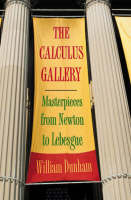
The Calculus Gallery
Princeton University Press (Verlag)
978-0-691-13626-4 (ISBN)
- Titel ist leider vergriffen;
keine Neuauflage - Artikel merken
More than three centuries after its creation, calculus remains a dazzling intellectual achievement and the gateway into higher mathematics. This book charts its growth and development by sampling from the work of some of its foremost practitioners, beginning with Isaac Newton and Gottfried Wilhelm Leibniz in the late seventeenth century and continuing to Henri Lebesgue at the dawn of the twentieth--mathematicians whose achievements are comparable to those of Bach in music or Shakespeare in literature. William Dunham lucidly presents the definitions, theorems, and proofs. "Students of literature read Shakespeare; students of music listen to Bach," he writes. But this tradition of studying the major works of the "masters" is, if not wholly absent, certainly uncommon in mathematics. This book seeks to redress that situation. Like a great museum, The Calculus Gallery is filled with masterpieces, among which are Bernoulli's early attack upon the harmonic series (1689), Euler's brilliant approximation of pi (1779), Cauchy's classic proof of the fundamental theorem of calculus (1823), Weierstrass's mind-boggling counterexample (1872), and Baire's original "category theorem" (1899).
Collectively, these selections document the evolution of calculus from a powerful but logically chaotic subject into one whose foundations are thorough, rigorous, and unflinching--a story of genius triumphing over some of the toughest, most subtle problems imaginable. Anyone who has studied and enjoyed calculus will discover in these pages the sheer excitement each mathematician must have felt when pushing into the unknown. In touring The Calculus Gallery, we can see how it all came to be.
William Dunham, Koehler Professor of Mathematics at Muhlenberg College, is the author of "Journey Through Genius: The Great Theorems of Mathematics"; "The Mathematical Universe"; and "Euler: The Master of Us All". He has received the Mathematical Association of America's George Polya, Trevor Evans, and Lester R. Ford awards, as well as its Beckenbach Prize for expository writing.
Illustrations ix Acknowledgments xiii INTRODUCTION 1 CHAPTER 1: Newton 5 CHAPTER 2: Leibniz 20 CHAPTER 3: The Bernoullis 35 CHAPTER 4: Euler 52 CHAPTER 5: First Interlude 69 CHAPTER 6: Cauchy 76 CHAPTER 7: Riemann 96 CHAPTER 8: Liouville 116 CHAPTER 9: Weierstrass 128 CHAPTER 10: Second Interlude 149 CHAPTER 11: Cantor 158 CHAPTER 12: Volterra 170 CHAPTER 13: Baire 183 CHAPTER 14: Lebesgue 200 Afterword 220 Notes 223 Index 233
| Erscheint lt. Verlag | 21.7.2008 |
|---|---|
| Zusatzinfo | 19 halftones. 44 line illus. |
| Verlagsort | New Jersey |
| Sprache | englisch |
| Maße | 152 x 235 mm |
| Gewicht | 369 g |
| Themenwelt | Mathematik / Informatik ► Mathematik ► Analysis |
| Mathematik / Informatik ► Mathematik ► Geschichte der Mathematik | |
| ISBN-10 | 0-691-13626-2 / 0691136262 |
| ISBN-13 | 978-0-691-13626-4 / 9780691136264 |
| Zustand | Neuware |
| Haben Sie eine Frage zum Produkt? |
aus dem Bereich


